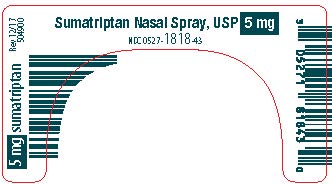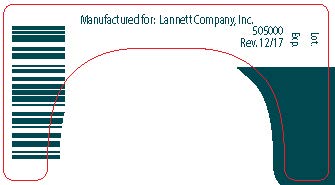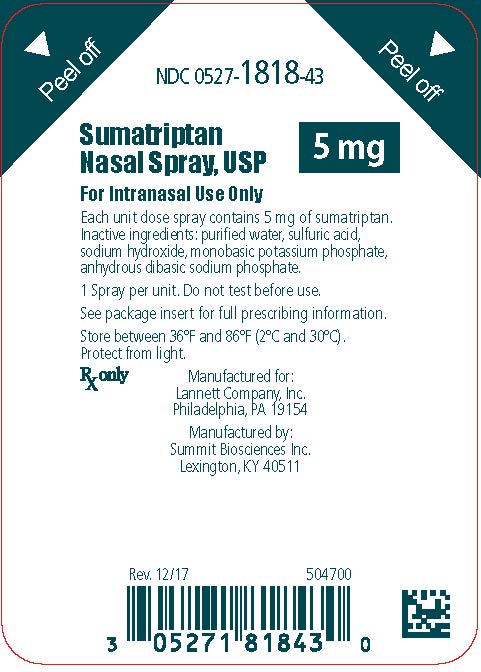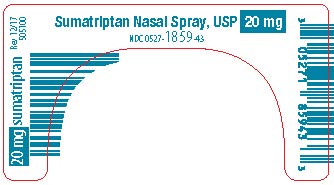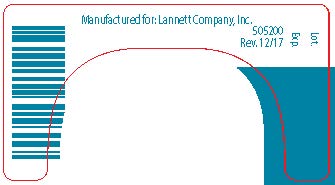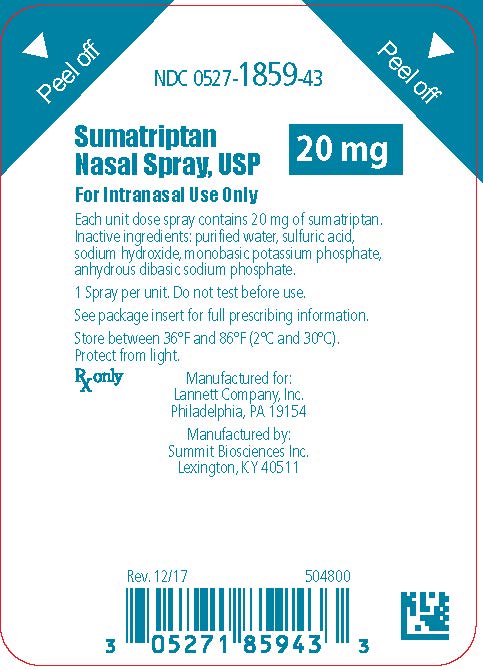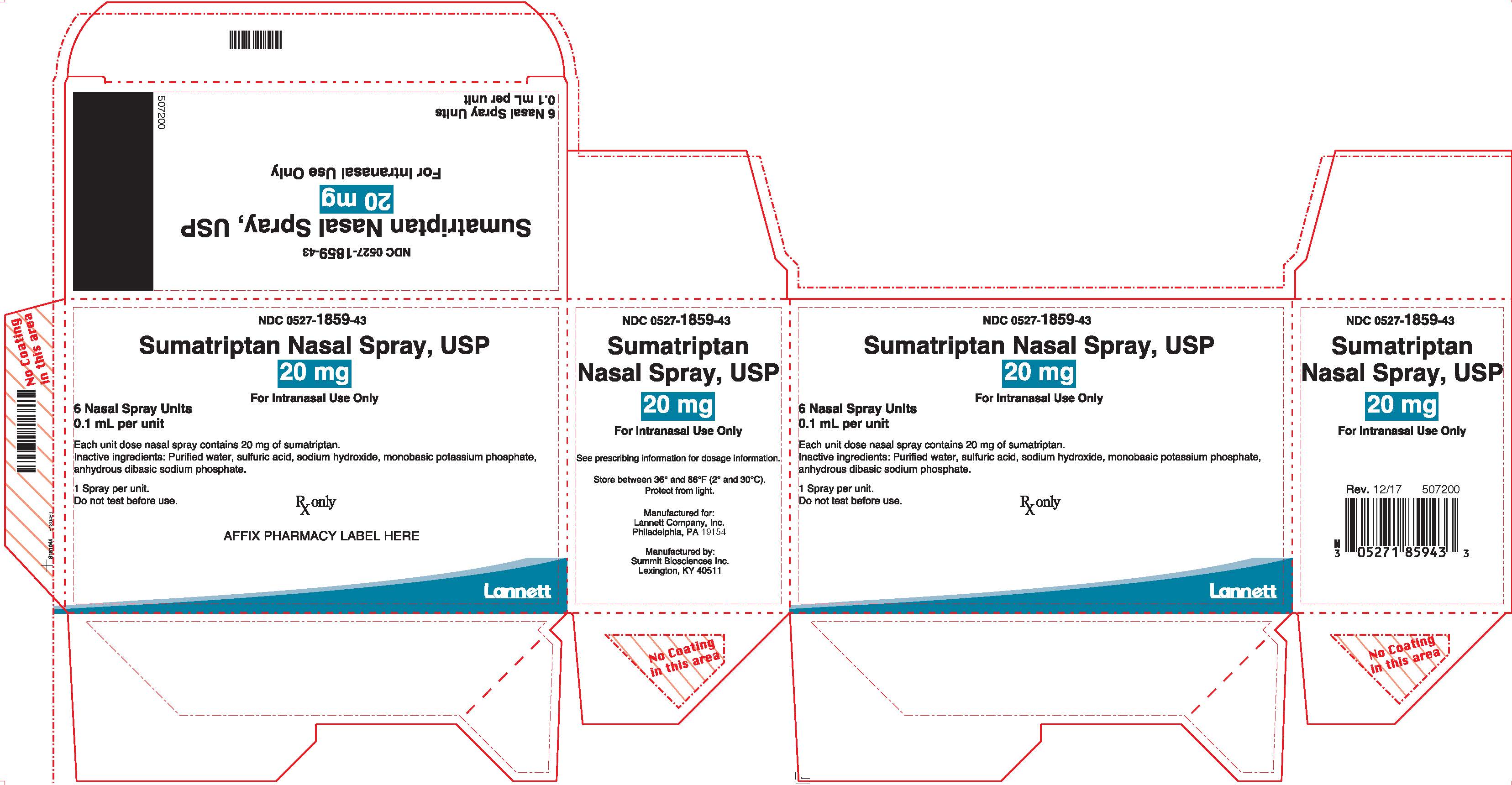Sumatriptan by Lannett Company, Inc. / Summit Biosciences, Inc. SUMATRIPTAN spray
Sumatriptan by
Drug Labeling and Warnings
Sumatriptan by is a Prescription medication manufactured, distributed, or labeled by Lannett Company, Inc., Summit Biosciences, Inc.. Drug facts, warnings, and ingredients follow.
Drug Details [pdf]
-
HIGHLIGHTS OF PRESCRIBING INFORMATION
These highlights do not include all the information needed to use SUMATRIPTAN Nasal Spray, USP safely and effectively. See full prescribing information for SUMATRIPTAN Nasal Spray, USP.
SUMATRIPTAN Nasal Spray, USP
Initial U.S. Approval: 1992INDICATIONS AND USAGE
Sumatriptan is a serotonin (5-HT1B/1D) receptor agonist (triptan) indicated for acute treatment of migraine with or without aura in adults. (1)
Limitations of Use:
DOSAGE AND ADMINISTRATION
CONTRAINDICATIONS
- History of coronary artery disease or coronary artery vasospasm (4)
- Wolff-Parkinson-White syndrome or other cardiac accessory conduction pathway disorders (4)
- History of stroke, transient ischemic attack, or hemiplegic or basilar migraine (4)
- Peripheral vascular disease (4)
- Ischemic bowel disease (4)
- Uncontrolled hypertension (4)
- Recent (within 24 hours) use of another 5-HT1 agonist (e.g., another triptan) or of an ergotamine-containing medication. (4)
- Concurrent or recent (past 2 weeks) use of monoamine oxidase-A inhibitor. (4)
- Hypersensitivity to sumatriptan (angioedema and anaphylaxis seen). (4)
- Severe hepatic impairment (4)
WARNINGS AND PRECAUTIONS
- Myocardial ischemia/infarction and Prinzmetal’s angina: Perform cardiac evaluation in patients with multiple cardiovascular risk factors. (5.1)
- Arrhythmias: Discontinue sumatriptan if occurs. (5.2)
- Chest/throat/neck/jaw pain, tightness, pressure, or heaviness: Generally not associated with myocardial ischemia; evaluate for coronary artery disease in patients at high risk. (5.3)
- Cerebral hemorrhage, subarachnoid hemorrhage, and stroke: Discontinue sumatriptan if occurs. (5.4)
- Gastrointestinal ischemic reactions and peripheral vasospastic reactions: Discontinue sumatriptan if occurs. (5.5)
- Medication overuse headache: Detoxification may be necessary. (5.6)
- Serotonin syndrome: Discontinue sumatriptan if occurs. (5.7)
- Seizures: Use with caution in patients with epilepsy or a lowered seizure threshold. (5.11)
ADVERSE REACTIONS
Most common adverse reactions (≥1% and >placebo) were burning sensation, disorder/discomfort of nasal cavity/sinuses, throat discomfort, nausea and/or vomiting, bad/unusual taste, and dizziness/vertigo. (6.1)
To report SUSPECTED ADVERSE REACTIONS, contact Lannett Company, Inc. at 1-844-834-0530 or FDA at 1-800-FDA-1088 or www.fda.gov/medwatch.
USE IN SPECIFIC POPULATIONS
Pregnancy: Based on animal data, may cause fetal harm. (8.1)
See 17 for PATIENT COUNSELING INFORMATION and FDA-approved patient labeling.
Revised: 5/2019
-
Table of Contents
FULL PRESCRIBING INFORMATION: CONTENTS*
1 INDICATIONS AND USAGE
2 DOSAGE AND ADMINISTRATION
3 DOSAGE FORMS AND STRENGTHS
4 CONTRAINDICATIONS
5 WARNINGS AND PRECAUTIONS
5.1 Myocardial Ischemia, Myocardial Infarction, and Prinzmetal’s Angina
5.2 Arrhythmias
5.3 Chest, Throat, Neck, and/or Jaw Pain/Tightness/Pressure
5.4 Cerebrovascular Events
5.5 Other Vasospasm Reactions
5.6 Medication Overuse Headache
5.7 Serotonin Syndrome
5.8 Increase in Blood Pressure
5.9 Local Irritation
5.10 Anaphylactic/Anaphylactoid Reactions
5.11 Seizures
6 ADVERSE REACTIONS
6.1 Clinical Trials Experience
6.2 Postmarketing Experience
7 DRUG INTERACTIONS
7.1 Ergot-Containing Drugs
7.2 Monoamine Oxidase-A Inhibitors
7.3 Other 5-HT1 Agonists
7.4 Selective Serotonin Reuptake Inhibitors/Serotonin Norepinephrine Reuptake Inhibitors and Serotonin Syndrome
8 USE IN SPECIFIC POPULATIONS
8.1 Pregnancy
8.2 Lactation
8.4 Pediatric Use
8.5 Geriatric Use
10 OVERDOSAGE
11 DESCRIPTION
12 CLINICAL PHARMACOLOGY
12.1 Mechanism of Action
12.2 Pharmacodynamics
12.3 Pharmacokinetics
13 NONCLINICAL TOXICOLOGY
13.1 Carcinogenesis, Mutagenesis, Impairment of Fertility
13.2 Animal Toxicology and/or Pharmacology
14 CLINICAL STUDIES
16 HOW SUPPLIED/STORAGE AND HANDLING
17 PATIENT COUNSELING INFORMATION
- * Sections or subsections omitted from the full prescribing information are not listed.
-
1 INDICATIONS AND USAGE
Sumatriptan nasal spray, USP is indicated for the acute treatment of migraine with or without aura in adults.
Limitations of Use:
- Use only if a clear diagnosis of migraine headache has been established. If a patient has no response to the first migraine attack treated with sumatriptan, reconsider the diagnosis of migraine before sumatriptan is administered to treat any subsequent attacks.
- Sumatriptan is not indicated for the prevention of migraine attacks.
- Safety and effectiveness of sumatriptan nasal spray, USP have not been established for cluster headache.
-
2 DOSAGE AND ADMINISTRATION
The recommended adult dose of sumatriptan nasal spray, USP for the acute treatment of migraine is 5 mg, 10 mg, or 20 mg. The 20-mg dose may provide a greater effect than the 5-mg and 10-mg doses, but may have a greater risk of adverse reactions [see Clinical Studies (14)].
The 5-mg and 20-mg doses are given as a single spray in 1 nostril. The 10-mg dose may be achieved by the administration of a single 5-mg dose in each nostril.
If the migraine has not resolved by 2 hours after taking sumatriptan nasal spray, USP, or returns after a transient improvement, 1 additional dose may be administered at least 2 hours after the first dose. The maximum daily dose is 40 mg in a 24-hour period.
The safety of treating an average of more than 4 headaches in a 30-day period has not been established.
- 3 DOSAGE FORMS AND STRENGTHS
-
4 CONTRAINDICATIONS
Sumatriptan nasal spray, USP is contraindicated in patients with:
- Ischemic coronary artery disease (CAD) (angina pectoris, history of myocardial infarction, or documented silent ischemia) or coronary artery vasospasm, including Prinzmetal’s angina [see Warnings and Precautions (5.1)]
- Wolff-Parkinson-White syndrome or arrhythmias associated with other cardiac accessory conduction pathway disorders [see Warnings and Precautions (5.2)]
- History of stroke, transient ischemic attack (TIA), or history of hemiplegic or basilar migraine because these patients are at a higher risk of stroke [see Warnings and Precautions (5.4)]
- Peripheral vascular disease [see Warnings and Precautions (5.5)]
- Ischemic bowel disease [see Warnings and Precautions (5.5)]
- Uncontrolled hypertension [see Warnings and Precautions (5.8)]
- Recent use (i.e., within 24 hours) of ergotamine-containing medication, ergot-type medication (such as dihydroergotamine or methysergide), or another 5-hydroxytryptamine1 (5-HT1) agonist [see Drug Interactions (7.1, 7.3)]
- Concurrent administration of a monoamine oxidase (MAO)-A inhibitor or recent (within 2 weeks) use of an MAO-A inhibitor [see Drug Interactions (7.2) and Clinical Pharmacology (12.3)]
- Hypersensitivity to sumatriptan (angioedema and anaphylaxis seen) [see Warnings and Precautions (5.10)]
- Severe hepatic impairment [see Clinical Pharmacology (12.3)]
-
5 WARNINGS AND PRECAUTIONS
5.1 Myocardial Ischemia, Myocardial Infarction, and Prinzmetal’s Angina
The use of sumatriptan nasal spray, USP is contraindicated in patients with ischemic or vasospastic CAD. There have been rare reports of serious cardiac adverse reactions, including acute myocardial infarction, occurring within a few hours following administration of sumatriptan nasal spray, USP. Some of these reactions occurred in patients without known CAD. Sumatriptan nasal spray, USP may cause coronary artery vasospasm (Prinzmetal’s angina), even in patients without a history of CAD.
Perform a cardiovascular evaluation in triptan-naive patients who have multiple cardiovascular risk factors (e.g., increased age, diabetes, hypertension, smoking, obesity, strong family history of CAD) prior to receiving sumatriptan nasal spray, USP. If there is evidence of CAD or coronary artery vasospasm, sumatriptan nasal spray, USP is contraindicated. For patients with multiple cardiovascular risk factors who have a negative cardiovascular evaluation, consider administering the first dose of sumatriptan nasal spray, USP in a medically supervised setting and performing an electrocardiogram (ECG) immediately following administration of sumatriptan nasal spray, USP. For such patients, consider periodic cardiovascular evaluation in intermittent long-term users of sumatriptan nasal spray, USP.
5.2 Arrhythmias
Life-threatening disturbances of cardiac rhythm, including ventricular tachycardia and ventricular fibrillation leading to death, have been reported within a few hours following the administration of 5-HT1 agonists. Discontinue sumatriptan nasal spray, USP if these disturbances occur. Sumatriptan nasal spray, USP is contraindicated in patients with Wolff-Parkinson-White syndrome or arrhythmias associated with other cardiac accessory conduction pathway disorders.
5.3 Chest, Throat, Neck, and/or Jaw Pain/Tightness/Pressure
Sensations of tightness, pain, pressure, and heaviness in the precordium, throat, neck, and jaw may occur after treatment with sumatriptan nasal spray, USP and are usually non-cardiac in origin. However, perform a cardiac evaluation if these patients are at high cardiac risk. The use of sumatriptan nasal spray, USP is contraindicated in patients with CAD and those with Prinzmetal’s variant angina.
5.4 Cerebrovascular Events
Cerebral hemorrhage, subarachnoid hemorrhage, and stroke have occurred in patients treated with 5-HT1 agonists, and some have resulted in fatalities. In a number of cases, it appears possible that the cerebrovascular events were primary, the 5-HT1 agonist having been administered in the incorrect belief that the symptoms experienced were a consequence of migraine when they were not. Also, patients with migraine may be at increased risk of certain cerebrovascular events (e.g., stroke, hemorrhage, TIA). Discontinue sumatriptan nasal spray, USP if a cerebrovascular event occurs.
Before treating headaches in patients not previously diagnosed as migraineurs, and in migraineurs who present with atypical symptoms, exclude other potentially serious neurological conditions. Sumatriptan nasal spray, USP is contraindicated in patients with a history of stroke or TIA.
5.5 Other Vasospasm Reactions
Sumatriptan nasal spray, USP may cause non-coronary vasospastic reactions, such as peripheral vascular ischemia, gastrointestinal vascular ischemia and infarction (presenting with abdominal pain and bloody diarrhea), splenic infarction, and Raynaud’s syndrome. In patients who experience symptoms or signs suggestive of non-coronary vasospasm reaction following the use of any 5-HT1 agonist, rule out a vasospastic reaction before using additional sumatriptan nasal spray, USP.
Reports of transient and permanent blindness and significant partial vision loss have been reported with the use of 5-HT1 agonists. Since visual disorders may be part of a migraine attack, a causal relationship between these events and the use of 5-HT1 agonists has not been clearly established.
5.6 Medication Overuse Headache
Overuse of acute migraine drugs (e.g., ergotamine, triptans, opioids, or combination of these drugs for 10 or more days per month) may lead to exacerbation of headache (medication overuse headache). Medication overuse headache may present as migraine-like daily headaches or as a marked increase in frequency of migraine attacks. Detoxification of patients, including withdrawal of the overused drugs, and treatment of withdrawal symptoms (which often includes a transient worsening of headache) may be necessary.
5.7 Serotonin Syndrome
Serotonin syndrome may occur with sumatriptan nasal spray, USP, particularly during coadministration with selective serotonin reuptake inhibitors (SSRIs), serotonin norepinephrine reuptake inhibitors (SNRIs), tricyclic antidepressants (TCAs), and MAO inhibitors [see Drug Interactions (7.4)]. Serotonin syndrome symptoms may include mental status changes (e.g., agitation, hallucinations, coma), autonomic instability (e.g., tachycardia, labile blood pressure, hyperthermia), neuromuscular aberrations (e.g., hyperreflexia, incoordination), and/or gastrointestinal symptoms (e.g., nausea, vomiting, diarrhea). The onset of symptoms usually occurs within minutes to hours of receiving a new or a greater dose of a serotonergic medication. Discontinue sumatriptan nasal spray, USP if serotonin syndrome is suspected.
5.8 Increase in Blood Pressure
Significant elevation in blood pressure, including hypertensive crisis with acute impairment of organ systems, has been reported on rare occasions in patients treated with 5-HT1 agonists, including patients without a history of hypertension. Monitor blood pressure in patients treated with sumatriptan. Sumatriptan nasal spray, USP is contraindicated in patients with uncontrolled hypertension.
5.9 Local Irritation
Local irritative symptoms such as burning, numbness, paresthesia, discharge, and pain or soreness were reported in approximately 5% of patients in controlled clinical trials and were noted to be severe in about 1%. The symptoms were transient and generally resolved in less than 2 hours. Limited examinations of the nose and throat did not reveal any clinically noticeable injury in these patients. The consequences of extended and repeated use of sumatriptan nasal spray, USP on the nasal and/or respiratory mucosa have not been systematically evaluated in patients.
5.10 Anaphylactic/Anaphylactoid Reactions
Anaphylactic/anaphylactoid reactions have occurred in patients receiving sumatriptan. Such reactions can be life-threatening or fatal. In general, anaphylactic reactions to drugs are more likely to occur in individuals with a history of sensitivity to multiple allergens. Sumatriptan nasal spray, USP is contraindicated in patients with a history of hypersensitivity reaction to sumatriptan.
5.11 Seizures
Seizures have been reported following administration of sumatriptan. Some have occurred in patients with either a history of seizures or concurrent conditions predisposing to seizures. There are also reports in patients where no such predisposing factors are apparent. Sumatriptan nasal spray, USP should be used with caution in patients with a history of epilepsy or conditions associated with a lowered seizure threshold.
-
6 ADVERSE REACTIONS
The following adverse reactions are discussed in more detail in other sections of the prescribing information:
- Myocardial ischemia, myocardial infarction, and Prinzmetal’s angina [see Warnings and Precautions (5.1)]
- Arrhythmias [see Warnings and Precautions (5.2)]
- Chest, throat, neck, and/or jaw pain/tightness/pressure [see Warnings and Precautions (5.3)]
- Cerebrovascular events [see Warnings and Precautions (5.4)]
- Other vasospasm reactions [see Warnings and Precautions (5.5)]
- Medication overuse headache [see Warnings and Precautions (5.6)]
- Serotonin syndrome [see Warnings and Precautions (5.7)]
- Increase in blood pressure [see Warnings and Precautions (5.8)]
- Local irritation [see Warnings and Precautions (5.9)]
- Hypersensitivity reactions [see Contraindications (4), Warnings and Precautions (5.10)]
- Seizures [see Warnings and Precautions (5.11)]
6.1 Clinical Trials Experience
Because clinical trials are conducted under widely varying conditions, adverse reaction rates observed in the clinical trials of a drug cannot be directly compared with rates in the clinical trials of another drug and may not reflect the rates observed in practice.
Table 1 lists adverse reactions that occurred in worldwide placebo-controlled clinical trials in 3,419 patients with migraine. Only treatment-emergent adverse reactions that occurred at a frequency of 1% or more in the group treated with sumatriptan nasal spray, USP 20 mg and that occurred at a frequency greater than the placebo group are included in Table 1.
Table 1. Adverse Reactions Reported by at Least 1% of Patients and at a Greater Frequency than Placebo in Controlled Migraine Clinical Trials Percent of Patients Reporting Adverse Reaction Sumatriptan Nasal Spray, USP
5 mg
(n = 496)Sumatriptan Nasal Spray, USP
10 mg
(n = 1,007)Sumatriptan Nasal Spray, USP
20 mg
(n = 1,212)Placebo
(n = 704)Atypical sensations Burning sensation 0.4 0.6 1.4 0.1 Ear, nose, and throat
Disorder/discomfort of nasal cavity/sinuses
Throat discomfort
2.8
0.82.5
1.83.8
2.42.4
0.9Gastrointestinal
Nausea and/or vomiting
12.2 11.0 13.5 11.3 Neurological
Bad/unusual taste
Dizziness/vertigo
13.5
1.0
19.3
1.724.5
1.41.7
0.9The incidence of adverse reactions in controlled clinical trials was not affected by gender, weight, or age of the patients; use of prophylactic medications; or presence of aura. There were insufficient data to assess the impact of race on the incidence of adverse reactions.
6.2 Postmarketing Experience
The following adverse reactions have been identified during postapproval use of sumatriptan tablets, sumatriptan nasal spray, and sumatriptan injection. Because these reactions are reported voluntarily from a population of uncertain size, it is not always possible to reliably estimate their frequency or establish a causal relationship to drug exposure. These reactions have been chosen for inclusion due to either their seriousness, frequency of reporting, or causal connection to sumatriptan or a combination of these factors.
Cardiovascular
Hypotension, palpitations.
Neurological
Dystonia, tremor.
-
7 DRUG INTERACTIONS
7.1 Ergot-Containing Drugs
Ergot-containing drugs have been reported to cause prolonged vasospastic reactions. Because these effects may be additive, use of ergotamine-containing or ergot-type medications (like dihydroergotamine or methysergide) and sumatriptan nasal spray, USP within 24 hours of each other is contraindicated.
7.2 Monoamine Oxidase-A Inhibitors
MAO-A inhibitors increase systemic exposure by up to 7-fold. Therefore, the use of sumatriptan nasal spray, USP in patients receiving MAO-A inhibitors is contraindicated [see Clinical Pharmacology (12.3)].
7.3 Other 5-HT1 Agonists
Because their vasospastic effects may be additive, coadministration of sumatriptan nasal spray, USP and other 5-HT1 agonists (e.g., triptans) within 24 hours of each other is contraindicated.
7.4 Selective Serotonin Reuptake Inhibitors/Serotonin Norepinephrine Reuptake Inhibitors and Serotonin Syndrome
Cases of serotonin syndrome have been reported during coadministration of triptans and SSRIs, SNRIs, TCAs, and MAO inhibitors [see Warnings and Precautions (5.7)].
-
8 USE IN SPECIFIC POPULATIONS
8.1 Pregnancy
Risk Summary
Data from a prospective pregnancy exposure registry and epidemiological studies of pregnant women have not detected an increased frequency of birth defects or a consistent pattern of birth defects among women exposed to sumatriptan compared with the general population (see Data). In developmental toxicity studies in rats and rabbits, oral administration of sumatriptan to pregnant animals was associated with embryolethality, fetal abnormalities, and pup mortality. When administered by the intravenous route to pregnant rabbits, sumatriptan was embryolethal (see Data).
In the U.S. general population, the estimated background risk of major birth defects and of miscarriage in clinically recognized pregnancies is 2% to 4% and 15% to 20%, respectively. The reported rate of major birth defects among deliveries to women with migraine ranged from 2.2% to 2.9% and the reported rate of miscarriage was 17%, which were similar to rates reported in women without migraine.
Clinical Considerations
Disease-Associated Maternal and/or Embryo/Fetal Risk: Several studies have suggested that women with migraine may be at increased risk of preeclampsia during pregnancy.
Data
Human Data: The Sumatriptan/Naratriptan/Treximet (sumatriptan and naproxen sodium) Pregnancy Registry, a population-based international prospective study, collected data for sumatriptan from January 1996 to September 2012. The Registry documented outcomes of 626 infants and fetuses exposed to sumatriptan during pregnancy (528 with earliest exposure during the first trimester, 78 during the second trimester, 16 during the third trimester, and 4 unknown). The occurrence of major birth defects (excluding fetal deaths and induced abortions without reported defects and all spontaneous pregnancy losses) during first-trimester exposure to sumatriptan was 4.2% (20/478 [95% CI: 2.6% to 6.5%]) and during any trimester of exposure was 4.2% (24/576 [95% CI: 2.7% to 6.2%]). The sample size in this study had 80% power to detect at least a 1.73- to 1.91-fold increase in the rate of major malformations. The number of exposed pregnancy outcomes accumulated during the registry was insufficient to support definitive conclusions about overall malformation risk or for making comparisons of the frequencies of specific birth defects. Of the 20 infants with reported birth defects after exposure to sumatriptan in the first trimester, 4 infants had ventricular septal defects, including one infant who was exposed to both sumatriptan and naratriptan, and 3 infants had pyloric stenosis. No other birth defect was reported for more than 2 infants in this group.
In a study using data from the Swedish Medical Birth Register, live births to women who reported using triptans or ergots during pregnancy were compared with those of women who did not. Of the 2,257 births with first-trimester exposure to sumatriptan, 107 infants were born with malformations (relative risk 0.99 [95% CI: 0.91 to 1.21]). A study using linked data from the Medical Birth Registry of Norway to the Norwegian Prescription Database compared pregnancy outcomes in women who redeemed prescriptions for triptans during pregnancy, as well as a migraine disease comparison group who redeemed prescriptions for sumatriptan before pregnancy only, compared with a population control group. Of the 415 women who redeemed prescriptions for sumatriptan during the first trimester, 15 had infants with major congenital malformations (OR 1.16 [95% CI: 0.69 to 1.94]) while for the 364 women who redeemed prescriptions for sumatriptan before, but not during, pregnancy, 20 had infants with major congenital malformations (OR 1.83 [95% CI: 1.17 to 2.88]), each compared with the population comparison group. Additional smaller observational studies evaluating use of sumatriptan during pregnancy have not suggested an increased risk of teratogenicity.
Animal Data: Oral administration of sumatriptan to pregnant rats during the period of organogenesis resulted in an increased incidence of fetal blood vessel (cervicothoracic and umbilical) abnormalities. The highest no-effect dose for embryofetal developmental toxicity in rats was 60 mg/kg/day. Oral administration of sumatriptan to pregnant rabbits during the period of organogenesis resulted in increased incidences of embryolethality and fetal cervicothoracic vascular and skeletal abnormalities. Intravenous administration of sumatriptan to pregnant rabbits during the period of organogenesis resulted in an increased incidence of embryolethality. The highest oral and intravenous no-effect doses for developmental toxicity in rabbits were 15 and 0.75 mg/kg/day, respectively.
Oral administration of sumatriptan to rats prior to and throughout gestation resulted in embryofetal toxicity (decreased body weight, decreased ossification, increased incidence of skeletal abnormalities). The highest no-effect dose was 50 mg/kg/day. In offspring of pregnant rats treated orally with sumatriptan during organogenesis, there was a decrease in pup survival. The highest no-effect dose for this effect was 60 mg/kg/day. Oral treatment of pregnant rats with sumatriptan during the latter part of gestation and throughout lactation resulted in a decrease in pup survival. The highest no-effect dose for this finding was 100 mg/kg/day.
8.2 Lactation
Risk Summary
Sumatriptan is excreted in human milk following subcutaneous administration (see Data). There is no information regarding sumatriptan concentrations in milk from lactating women following administration of sumatriptan nasal spray, USP. There are no data on the effects of sumatriptan on the breastfed infant or the effects of sumatriptan on milk production.
The developmental and health benefits of breastfeeding should be considered along with the mother’s clinical need for sumatriptan nasal spray, USP and any potential adverse effects on the breastfed infant from sumatriptan or from the underlying maternal condition.
Clinical Considerations
Infant exposure to sumatriptan can be minimized by avoiding breastfeeding for 12 hours after treatment with sumatriptan nasal spray, USP.
Data
Following subcutaneous administration of a 6 mg dose of sumatriptan injection in 5 lactating volunteers, sumatriptan was present in milk.
8.4 Pediatric Use
Safety and effectiveness in pediatric patients have not been established. Sumatriptan nasal spray, USP is not recommended for use in patients younger than 18 years of age.
Two controlled clinical trials evaluated sumatriptan nasal spray, USP (5 to 20 mg) in 1,248 adolescent migraineurs aged 12 to 17 years who treated a single attack. The trials did not establish the efficacy of sumatriptan nasal spray, USP compared with placebo in the treatment of migraine in adolescents. Adverse reactions observed in these clinical trials were similar in nature to those reported in clinical trials in adults.
Five controlled clinical trials (2 single-attack trials, 3 multiple-attack trials) evaluating oral sumatriptan (25 to 100 mg) in pediatric patients aged 12 to 17 years enrolled a total of 701 adolescent migraineurs. These trials did not establish the efficacy of oral sumatriptan compared with placebo in the treatment of migraine in adolescents. Adverse reactions observed in these clinical trials were similar in nature to those reported in clinical trials in adults. The frequency of all adverse reactions in these patients appeared to be both dose- and age-dependent, with younger patients reporting reactions more commonly than older adolescents.
Postmarketing experience documents that serious adverse reactions have occurred in the pediatric population after use of subcutaneous, oral, and/or intranasal sumatriptan. These reports include reactions similar in nature to those reported rarely in adults, including stroke, visual loss, and death. A myocardial infarction has been reported in a 14-year-old male following the use of oral sumatriptan; clinical signs occurred within 1 day of drug administration. Clinical data to determine the frequency of serious adverse reactions in pediatric patients who might receive subcutaneous, oral, or intranasal sumatriptan are not presently available.
8.5 Geriatric Use
Clinical trials of sumatriptan nasal spray, USP did not include sufficient numbers of patients aged 65 and older to determine whether they respond differently from younger patients. Other reported clinical experience has not identified differences in responses between the elderly and younger patients. In general, dose selection for an elderly patient should be cautious, usually starting at the low end of the dosing range, reflecting the greater frequency of decreased hepatic, renal, or cardiac function and of concomitant disease or other drug therapy.
A cardiovascular evaluation is recommended for geriatric patients who have other cardiovascular risk factors (e.g., diabetes, hypertension, smoking, obesity, strong family history of CAD) prior to receiving sumatriptan nasal spray, USP [see Warnings and Precautions (5.1)].
-
10 OVERDOSAGE
In clinical trials, the highest single doses of sumatriptan nasal spray, USP administered without significant reactions were 40 mg to 12 volunteers and 40 mg to 85 subjects with migraine, which is twice the highest single recommended dose. In addition, 12 volunteers were administered a total daily dose of 60 mg (20 mg 3 times daily) for 3.5 days without significant adverse reactions.
Overdose in animals has been fatal and has been heralded by convulsions, tremor, paralysis, inactivity, ptosis, erythema of the extremities, abnormal respiration, cyanosis, ataxia, mydriasis, salivation, and lacrimation.
The elimination half-life of sumatriptan is approximately 2 hours [see Clinical Pharmacology (12.3)], and therefore monitoring of patients after overdose with sumatriptan nasal spray, USP should continue for at least 10 hours or while symptoms or signs persist.
It is unknown what effect hemodialysis or peritoneal dialysis has on the serum concentrations of sumatriptan.
-
11 DESCRIPTION
Sumatriptan nasal spray, USP contains sumatriptan, a selective 5-HT1B/1D receptor agonist. Sumatriptan is chemically designated as 3-[2-(dimethylamino)ethyl]-N-methyl-indole-5-methanesulfonamide, and it has the following structure:

The empirical formula is C14H21N3O2S, representing a molecular weight of 295.4. Sumatriptan is a white to off-white powder that is readily soluble in water and in saline.
Each sumatriptan nasal spray, USP contains 5 or 20 mg of sumatriptan in a 100-microL unit dose aqueous buffered solution containing purified water USP, sulfuric acid NF, sodium hydroxide NF, monobasic potassium phosphate NF, and anhydrous dibasic sodium phosphate USP. The pH of the solution is approximately 5.5. The osmolality of the solution is 372 or 742 mOsmol for the 5- and 20-mg sumatriptan nasal spray, USP, respectively.
-
12 CLINICAL PHARMACOLOGY
12.1 Mechanism of Action
Sumatriptan binds with high affinity to human cloned 5-HT1B/1D receptors. Sumatriptan presumably exerts its therapeutic effects in the treatment of migraine headache through agonist effects at the 5-HT1B/1D receptors on intracranial blood vessels and sensory nerves of the trigeminal system, which result in cranial vessel constriction and inhibition of pro-inflammatory neuropeptide release.
12.2 Pharmacodynamics
Blood Pressure
Significant elevation in blood pressure, including hypertensive crisis, has been reported in patients with and without a history of hypertension [see Warnings and Precautions (5.8)].
Peripheral (Small) Arteries
In healthy volunteers (N = 18), a trial evaluating the effects of sumatriptan on peripheral (small vessel) arterial reactivity failed to detect a clinically significant increase in peripheral resistance.
Heart Rate
Transient increases in blood pressure observed in some patients in clinical trials carried out during sumatriptan’s development as a treatment for migraine were not accompanied by any clinically significant changes in heart rate.
12.3 Pharmacokinetics
Absorption
In a trial of 20 female volunteers, the mean maximum concentration following a 5- and 20-mg intranasal dose was 5 and 16 ng/mL, respectively. The mean Cmax following a 6-mg subcutaneous injection is 71 ng/mL (range: 49 to 110 ng/mL). The mean Cmax is 18 ng/mL (range: 7 to 47 ng/mL) following oral dosing with 25 mg and 51 ng/mL (range: 28 to 100 ng/mL) following oral dosing with 100 mg of sumatriptan. In a trial of 24 male volunteers, the bioavailability relative to subcutaneous injection was low, approximately 17%, primarily due to presystemic metabolism and partly due to incomplete absorption.
Clinical and pharmacokinetic data indicate that administration of two 5-mg doses, 1 dose in each nostril, is equivalent to administration of a single 10-mg dose in 1 nostril.
Distribution
Protein binding, determined by equilibrium dialysis over the concentration range of 10 to 1,000 ng/mL, is low, approximately 14% to 21%. The effect of sumatriptan on the protein binding of other drugs has not been evaluated. The apparent volume of distribution is 2.7 L/kg.
Metabolism
In vitro studies with human microsomes suggest that sumatriptan is metabolized by MAO, predominantly the A isoenzyme. Most of a radiolabeled dose of sumatriptan excreted in the urine is the major metabolite indole acetic acid (IAA) or the IAA glucuronide, both of which are inactive.
Elimination
The elimination half-life of sumatriptan administered as a nasal spray is approximately 2 hours, similar to the half-life seen after subcutaneous injection. Only 3% of the dose is excreted in the urine as unchanged sumatriptan; 42% of the dose is excreted as the major metabolite, the indole acetic acid analogue of sumatriptan. The total plasma clearance is approximately 1,200 mL/min.
Specific Populations
Age: The pharmacokinetics of sumatriptan in the elderly (mean age: 72 years, 2 males and 4 females) and in subjects with migraine (mean age: 38 years, 25 males and 155 females) were similar to that in healthy male subjects (mean age: 30 years). Intranasal sumatriptan has not been evaluated for age differences.
Patients with Renal Impairment: The effect of renal impairment on the pharmacokinetics of sumatriptan has not been examined.
Patients with Hepatic Impairment: The effect of mild to moderate hepatic disease on the pharmacokinetics of the intranasal formulation of sumatriptan has not been evaluated. Sumatriptan bioavailability following intranasal administration is 17%, similar to that after oral administration (15%). Following oral administration, an approximately 70% increase in Cmax and AUC was observed in one small trial of patients with moderate liver impairment (n = 8) matched for sex, age and weight with healthy subjects (n = 8). Similar changes can be expected following intranasal administration.
The pharmacokinetics of sumatriptan in patients with severe hepatic impairment has not been studied. The use of sumatriptan nasal spray, USP in patients with severe hepatic impairment is contraindicated [see Contraindications (4)].
Racial Groups: The systemic clearance and Cmax of subcutaneous sumatriptan were similar in black (n = 34) and Caucasian (n = 38) healthy male subjects. Intranasal sumatriptan has not been evaluated for race differences.
Drug Interaction Studies
Monoamine Oxidase-A Inhibitors: Treatment with MAO-A inhibitors generally leads to an increase of sumatriptan plasma levels [see Contraindications (4), Drug Interactions (7.2)]. MAO inhibitors interaction studies have not been performed with intranasal sumatriptan.
Due to gut and hepatic metabolic first-pass effects, the increase of systemic exposure after coadministration of an MAO-A inhibitor with oral sumatriptan is greater than after coadministration of the MAO inhibitors with subcutaneous sumatriptan. The effects of an MAO inhibitor on systemic exposure after intranasal sumatriptan would be expected to be greater than the effect after subcutaneous sumatriptan but smaller than the effect after oral sumatriptan because only swallowed drug would be subject to first-pass effects.
In a trial of 14 healthy females, pretreatment with an MAO-A inhibitor decreased the clearance of subcutaneous sumatriptan, resulting in a 2-fold increase in the area under the sumatriptan plasma concentration-time curve (AUC), corresponding to a 40% increase in elimination half-life.
A small trial evaluating the effect of pretreatment with an MAO-A inhibitor on the bioavailability from a 25-mg oral sumatriptan tablet resulted in an approximately 7-fold increase in systemic exposure.
Xylometazoline: An in vivo drug interaction trial indicated that 3 drops of xylometazoline (0.1% w/v), a decongestant, administered 15 minutes prior to a 20-mg nasal dose of sumatriptan did not alter the pharmacokinetics of sumatriptan.
-
13 NONCLINICAL TOXICOLOGY
13.1 Carcinogenesis, Mutagenesis, Impairment of Fertility
Carcinogenesis
In carcinogenicity studies in mouse and rat in which sumatriptan was administered orally for 78 and 104 weeks, respectively, there was no evidence in either species of an increase in tumors related to sumatriptan administration.
Carcinogenicity studies of sumatriptan using the nasal route have not been conducted.
Mutagenesis
Sumatriptan was negative in in vitro (bacterial reverse mutation [Ames], gene cell mutation in Chinese hamster V79/HGPRT, chromosomal aberration in human lymphocytes) and in vivo (rat micronucleus) assays.
Impairment of Fertility
When sumatriptan (5, 50, or 500 mg/kg/day) was administered orally to male and female rats prior to and throughout the mating period, there was a treatment-related decrease in fertility secondary to a decrease in mating in animals treated with doses greater than 5 mg/kg/day. It is not clear whether this finding was due to an effect on males or females or both.
When sumatriptan was administered by subcutaneous injection to male and female rats prior to and throughout the mating period, there was no evidence of impaired fertility at doses up to 60 mg/kg/day.
Fertility studies of sumatriptan using the intranasal route have not been conducted.
13.2 Animal Toxicology and/or Pharmacology
Corneal Opacities
Dogs receiving oral sumatriptan developed corneal opacities and defects in the corneal epithelium. Corneal opacities were seen at the lowest dose tested, 2 mg/kg/day, and were present after 1 month of treatment. Defects in the corneal epithelium were noted in a 60-week study. Earlier examinations for these toxicities were not conducted and no-effect doses were not established.
-
14 CLINICAL STUDIES
The efficacy of sumatriptan nasal spray, USP in the acute treatment of migraine headaches was demonstrated in 8, randomized, double-blind, placebo-controlled trials, of which 5 used the recommended dosing regimen and used the marketed formulation. Patients enrolled in these 5 trials were predominately female (86%) and Caucasian (95%), with a mean age of 41 years (range: of 18 to 65 years). Patients were instructed to treat a moderate to severe headache. Headache response, defined as a reduction in headache severity from moderate or severe pain to mild or no pain, was assessed up to 2 hours after dosing. Associated symptoms such as nausea, photophobia, and phonophobia were also assessed. Maintenance of response was assessed for up to 24 hours postdose. A second dose of sumatriptan nasal spray, USP or other medication was allowed 2 to 24 hours after the initial treatment for recurrent headache. The frequency and time to use of these additional treatments were also determined. In all trials, doses of 10 and 20 mg were compared with placebo in the treatment of 1 to 3 migraine attacks. Patients received doses as a single spray into 1 nostril. In 2 trials, a 5-mg dose was also evaluated.
In all 5 trials utilizing the market formulation and recommended dosage regimen, the percentage of patients achieving headache response 2 hours after treatment was significantly greater among patients receiving sumatriptan nasal spray, USP at all doses (with one exception) compared with those who received placebo. In 4 of the 5 trials, there was a statistically significant greater percentage of patients with headache response at 2 hours in the 20-mg group when compared with the lower-dose groups (5 and 10 mg). There were no statistically significant differences between the 5- and 10-mg dose groups in any trial. The results from the 5 controlled clinical trials are summarized in Table 2. Note that, in general, comparisons of results obtained in trials conducted under different conditions by different investigators with different samples of patients are ordinarily unreliable for purposes of quantitative comparison.
Table 2. Percentage of Patients with Headache Response (No or Mild Pain) 2 Hours following Treatment Sumatriptan Nasal Spray, USP
5 mgSumatriptan Nasal Spray, USP
10 mgSumatriptan Nasal Spray, USP
20 mgPlacebo Trial 1 49%a
(n = 121)46%a
(n = 112)64%a,b,c
(n = 118)25%
(n = 63)Trial 2 Not applicable 44%a
(n = 273)55%a,b
(n = 277)25%
(n = 138)Trial 3 Not applicable 54%a
(n = 106)63%a
(n = 202)35%
(n = 100)Trial 4 Not applicable 43%
(n = 106)62%a,b
(n = 215)29%
(n = 112)Trial 5d 45%a
(n = 296)53%a
(n = 291)60%a,c
(n = 286)36%
(n = 198)a P<0.05 in comparison with placebo.
b P<0.05 in comparison with 10 mg.
c P<0.05 in comparison with 5 mg.
d Data are for attack 1 only of multi-attack trial for comparison.
The estimated probability of achieving an initial headache response over the 2 hours following treatment is depicted in Figure 1.
Figure 1. Estimated Probability of Achieving Initial Headache Response within 120 Minutesa
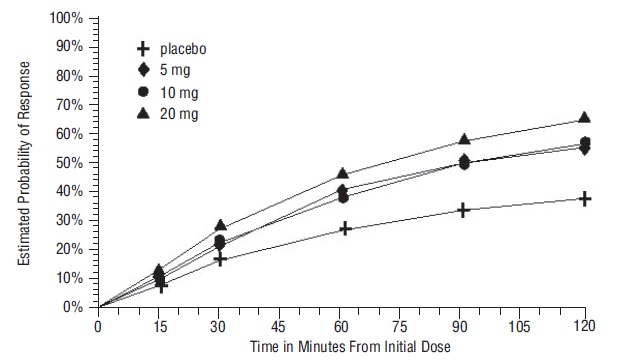
- The figure shows the probability over time of obtaining headache response (no or mild pain) following treatment with intranasal sumatriptan. The averages displayed are based on pooled data from the 5 clinical controlled trials providing evidence of efficacy. Kaplan-Meier plot with patients not achieving response within 120 minutes censored to 120 minutes.
For patients with migraine-associated nausea, photophobia, and phonophobia at baseline, there was a lower incidence of these symptoms at 2 hours following administration of sumatriptan nasal spray, USP compared with placebo.
Two to 24 hours following the initial dose of study treatment, patients were allowed to use additional treatment for pain relief in the form of a second dose of study treatment or other medication. The estimated probability of patients taking a second dose or other medication for migraine over the 24 hours following the initial dose of study treatment is summarized in Figure 2.
Figure 2. The Estimated Probability of Patients Taking a Second Dose or Other Medication for Migraine over the 24 Hours following the Initial Dose of Study Treatmenta
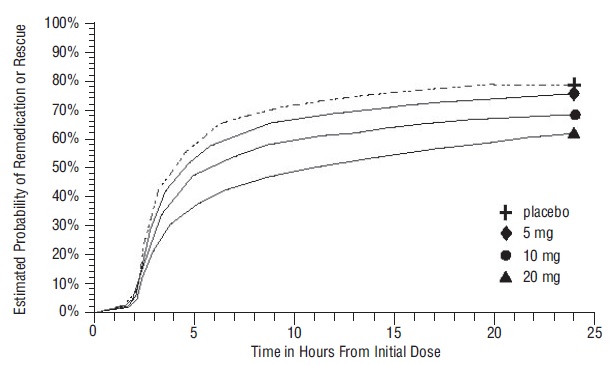
- Kaplan-Meier plot based on data obtained in the 3 clinical controlled trials providing evidence of efficacy with patients not using additional treatments censored to 24 hours. Plot also includes patients who had no response to the initial dose. No remedication was allowed within 2 hours postdose.
There is evidence that doses above 20 mg do not provide a greater effect than 20 mg. There was no evidence to suggest that treatment with sumatriptan was associated with an increase in the severity of recurrent headaches. The efficacy of sumatriptan nasal spray, USP was unaffected by presence of aura; duration of headache prior to treatment; gender, age, or weight of the subject; or concomitant use of common migraine prophylactic drugs (e.g., beta-blockers, calcium channel blockers, tricyclic antidepressants). There were insufficient data to assess the impact of race on efficacy.
-
16 HOW SUPPLIED/STORAGE AND HANDLING
Sumatriptan nasal spray, USP 5 mg (NDC: 0527-1818-43) and 20 mg (NDC: 0527-1859-43) are each supplied in boxes of 6 nasal spray devices. Each unit dose spray supplies 5 mg and 20 mg, respectively, of sumatriptan.
Store between 2°C and 30°C (36°F and 86°F). Protect from light.
-
17 PATIENT COUNSELING INFORMATION
Advise the patient to read the FDA-approved patient labeling (Patient Information).
Risk of Myocardial Ischemia and/or Infarction, Prinzmetal’s Angina, Other Vasospasm-Related Events, Arrhythmias, and Cerebrovascular Events
Inform patients that sumatriptan nasal spray, USP may cause serious cardiovascular side effects such as myocardial infarction or stroke. Although serious cardiovascular events can occur without warning symptoms, patients should be alert for the signs and symptoms of chest pain, shortness of breath, irregular heartbeat, significant rise in blood pressure, weakness, and slurring of speech and should ask for medical advice if any indicative sign or symptoms are observed. Apprise patients of the importance of this follow-up [see Warnings and Precautions (5.1, 5.2, 5.4, 5.5, 5.8)].
Anaphylactic/Anaphylactoid Reactions
Inform patients that anaphylactic/anaphylactoid reactions have occurred in patients receiving sumatriptan nasal spray, USP. Such reactions can be life-threatening or fatal. In general, anaphylactic reactions to drugs are more likely to occur in individuals with a history of sensitivity to multiple allergens [see Contraindications (4), Warnings and Precautions (5.10)].
Concomitant Use with Other Triptans or Ergot Medications
Inform patients that use of sumatriptan nasal spray, USP within 24 hours of another triptan or an ergot-type medication (including dihydroergotamine or methysergide) is contraindicated [see Contraindications (4), Drug Interactions (7.1, 7.3)].
Serotonin Syndrome
Caution patients about the risk of serotonin syndrome with the use of sumatriptan nasal spray, USP or other triptans, particularly during combined use with SSRIs, SNRIs, TCAs, and MAO inhibitors [see Warnings and Precautions (5.7), Drug Interactions (7.4)].
Medication Overuse Headache
Inform patients that use of acute migraine drugs for 10 or more days per month may lead to an exacerbation of headache and encourage patients to record headache frequency and drug use (e.g., by keeping a headache diary) [see Warnings and Precautions (5.6)].
Pregnancy
Advise patients to notify their healthcare provider if they become pregnant during treatment or plan to become pregnant [see Use in Specific Populations (8.1)].
Lactation
Advise patients to notify their healthcare provider if they are breastfeeding or plan to breastfeed [see Use in Specific Populations (8.2)].
Ability to Perform Complex Tasks
Treatment with sumatriptan nasal spray, USP may cause somnolence and dizziness; instruct patients to evaluate their ability to perform complex tasks after administration of sumatriptan nasal spray, USP.
Local Irritation
Inform patients that they may experience local irritation of their nose and throat. The symptoms will generally resolve in less than 2 hours.
How to Use Sumatriptan Nasal Spray, USP
Provide patients instruction on the proper use of sumatriptan nasal spray, USP. Caution patients to avoid spraying the contents of the device in their eyes.
Manufactured for:
Lannett Company, Inc.
Philadelphia, PA 19136Manufactured by:
Summit Biosciences, Inc.
Lexington, KY 40511509701
Rev.05/2019
-
Patient Information
Sumatriptan (soo ma TRIP tan)
Nasal Spray, USPRead this Patient Information before you start using sumatriptan nasal spray, USP and each time you get a refill. There may be new information. This information does not take the place of talking with your healthcare provider about your medical condition or treatment. What is the most important information I should know about sumatriptan nasal spray, USP? Sumatriptan can cause serious side effects, including:
Heart attack and other heart problems. Heart problems may lead to death.
Stop taking sumatriptan nasal spray, USP and get emergency medical help right away if you have any of the following symptoms of a heart attack:
-
discomfort in the center of your chest that lasts for more than a few minutes, or that goes away and comes back
-
severe tightness, pain, pressure, or heaviness in your chest, throat, neck, or jaw
-
pain or discomfort in your arms, back, neck, jaw, or stomach
-
shortness of breath with or without chest discomfort
-
breaking out in a cold sweat
-
nausea or vomiting
-
feeling lightheaded
Sumatriptan nasal spray, USP is not for people with risk factors for heart disease unless a heart exam is done and shows no problem.
You have a higher risk for heart disease if you:
- have high blood pressure
- have high cholesterol levels
- smoke
- are overweight
- have diabetes
- have a family history of heart disease
What is sumatriptan nasal spray, USP?
Sumatriptan nasal spray, USP is a prescription medicine used to treat acute migraine headaches with or without aura in adults.
Sumatriptan nasal spray, USP is not used to treat other types of headaches such as hemiplegic (that make you unable to move on one side of your body) or basilar (rare form of migraine with aura) migraines.
Sumatriptan nasal spray, USP is not used to prevent or decrease the number of migraine headaches you have.
It is not known if sumatriptan nasal spray, USP is safe and effective to treat cluster headaches.
It is not known if sumatriptan nasal spray, USP is safe and effective in children under 18 years of age.
Do not use sumatriptan nasal spray, USP if you have:
-
heart problems or a history of heart problems
-
narrowing of blood vessels to your legs, arms, stomach, or kidneys (peripheral vascular disease)
-
uncontrolled high blood pressure
-
severe liver problems
-
hemiplegic migraines or basilar migraines. If you are not sure if you have these types of migraines, ask your healthcare provider.
-
had a stroke, transient ischemic attacks (TIAs), or problems with your blood circulation
-
taken any of the following medicines in the last 24 hours:
-
almotriptan (AXERT)
-
eletriptan (RELPAX)
-
frovatriptan (FROVA)
-
naratriptan (AMERGE)
-
rizatriptan (MAXALT, MAXALT-MLT)
-
sumatriptan and naproxen (TREXIMET)
-
ergotamines (CAFERGOT, ERGOMAR, MIGERGOT)
-
dihydroergotamine (D.H.E. 45, MIGRANAL)
Ask your healthcare provider if you are not sure if your medicine is listed above.
-
- an allergy to sumatriptan or any of the ingredients in sumatriptan nasal spray, USP. See the end of this leaflet for a complete list of ingredients in sumatriptan nasal spray, USP.
Before you use sumatriptan nasal spray, USP, tell your healthcare provider about all of your medical conditions, including if you:
-
have high blood pressure.
-
have high cholesterol.
-
have diabetes.
-
smoke.
-
are overweight.
-
have heart problems or family history of heart problems or stroke.
-
have kidney problems.
-
have liver problems.
-
have had epilepsy or seizures.
-
are not using effective birth control.
-
are pregnant or plan to become pregnant. It is not known if sumatriptan nasal spray, USP can harm your unborn baby.
- are breastfeeding or plan to breastfeed. Sumatriptan passes into your breast milk. It is not known if this can harm your baby. Talk with your healthcare provider about the best way to feed your baby if you use sumatriptan nasal spray, USP.
Tell your healthcare provider about all the medicines you take, including prescription and over-the-counter medicines, vitamins, and herbal supplements.
Sumatriptan and certain other medicines can affect each other, causing serious side effects.
Especially tell your healthcare provider if you take antidepressant medicines called:
-
selective serotonin reuptake inhibitors (SSRIs)
-
serotonin norepinephrine reuptake inhibitors (SNRIs)
-
tricyclic antidepressants (TCAs)
-
monoamine oxidase inhibitors (MAOIs)
Ask your healthcare provider or pharmacist for a list of these medicines if you are not sure.
Know the medicines you take. Keep a list of them to show your healthcare provider or pharmacist when you get a new medicine.
How should I use sumatriptan nasal spray, USP?
-
Certain people should use their first dose of sumatriptan nasal spray, USP in their healthcare provider’s office or in another medical setting. Ask your healthcare provider if you should use your first dose in a medical setting.
-
Use sumatriptan nasal spray, USP exactly as your healthcare provider tells you to use it.
-
Your healthcare provider may change your dose. Do not change your dose without first talking with your healthcare provider.
-
If you do not get any relief after your first nasal spray, do not use a second nasal spray without first talking with your healthcare provider.
-
If your headache comes back after the first nasal spray or you only get some relief from your headache, you can use a second nasal spray 2 hours after the first nasal spray.
-
Do not use more than 40 mg of sumatriptan nasal spray, USP in a 24-hour period.
-
It is not known how using sumatriptan nasal spray, USP for a long time affects the nose and throat.
-
If you use too much sumatriptan nasal spray, USP, call your healthcare provider or go to the nearest hospital emergency room right away.
-
You should write down when you have headaches and when you use sumatriptan nasal spray, USP so you can talk with your healthcare provider about how sumatriptan nasal spray, USP is working for you.
What should I avoid while using sumatriptan nasal spray, USP?
Sumatriptan nasal spray, USP can cause dizziness, weakness, or drowsiness. If you have these symptoms, do not drive a car, use machinery, or do anything where you need to be alert.What are the possible side effects of sumatriptan nasal spray, USP?
Sumatriptan nasal spray, USP may cause serious side effects. See “What is the most important information I should know about sumatriptan nasal spray, USP?”
These serious side effects include:
-
changes in color or sensation in your fingers and toes (Raynaud’s syndrome)
-
stomach and intestinal problems (gastrointestinal and colonic ischemic events).
Symptoms of gastrointestinal and colonic ischemic events include:
- sudden or severe stomach pain
- stomach pain after meals
- weight loss
- fever
- nausea or vomiting
- constipation or diarrhea
- bloody diarrhea
-
problems with blood circulation to your legs and feet (peripheral vascular ischemia). Symptoms of peripheral vascular ischemia include:
-
cramping and pain in your legs or hips
-
feeling of heaviness or tightness in your leg muscles
-
burning or aching pain in your feet or toes while resting
-
numbness, tingling, or weakness in your legs
-
cold feeling or color changes in 1 or both legs or feet
-
-
medication overuse headaches. Some people who use too many sumatriptan nasal sprays may have worse headaches (medication overuse headache). If your headaches get worse, your healthcare provider may decide to stop your treatment with sumatriptan nasal spray, USP.
-
serotonin syndrome. Serotonin syndrome is a rare but serious problem that can happen in people using sumatriptan, especially if sumatriptan nasal spray, USP is used with anti-depressant medicines called SSRIs or SNRIs.
Call your healthcare provider right away if you have any of the following symptoms of serotonin syndrome:
-
-
mental change
-
fast heartbeat
-
changes in blood pressure
-
high body temperature
-
tight muscles
-
trouble walking
-
-
local irritation. Some people who use sumatriptan nasal spray, USP may have irritation of their throat and nose. Symptoms of local irritation of the throat and nose include: burning, numbness, tingling sensation, nasal discharge, pain or soreness
-
hives (itchy bumps); swelling of your tongue, mouth, or throat.
- seizures. Seizures have happened in people taking sumatriptan nasal spray, USP who have never had seizures before. Talk with your healthcare provider about your chance of having seizures while you take sumatriptan nasal spray, USP.
The most common side effects of sumatriptan nasal spray, USP include:
-
unusual or bad taste in your mouth
-
nausea
-
vomiting
-
dizziness
-
warm, hot, burning feeling
Tell your healthcare provider if you have any side effect that bothers you or that does not go away.
These are not all the possible side effects of sumatriptan nasal spray, USP.
Call your doctor for medical advice about side effects. You may report side effects to FDA at 1-800-FDA-1088.
How should I store sumatriptan nasal spray, USP?
-
Store sumatriptan nasal spray, USP between 36°F to 86°F (2°C to 30°C).
-
Store your medicine away from light.
General information about the safe and effective use of sumatriptan nasal spray, USP.
Medicines are sometimes prescribed for purposes other than those listed in Patient Information leaflets. Do not use sumatriptan nasal spray, USP for a condition for which it was not prescribed. Do not give sumatriptan nasal spray, USP to other people, even if they have the same symptoms you have. It may harm them.
This Patient Information leaflet summarizes the most important information about sumatriptan nasal spray, USP. If you would like more information, talk with your healthcare provider. You can ask your healthcare provider or pharmacist for information about sumatriptan nasal spray, USP that is written for healthcare professionals.
For more information, contact Lannett Company, Inc. at 1-844-834-0530.What are the ingredients in sumatriptan nasal spray, USP?
Active ingredient: sumatriptan
Inactive ingredients: purified water USP, sulfuric acid NF, sodium hydroxide NF, monobasic potassium phosphate NF, and dibasic sodium phosphate USP.IMITREX and AMERGE are registered trademarks of the GSK group of companies. The other brands listed are trademarks of their respective owners and are not owned by or licensed to Lannett Company, Inc. The makers of these brands are not affiliated with and do not endorse Lannett Company, Inc. or its products.
Manufactured for:
Lannett Company, Inc.
Philadelphia, PA 19136
Manufactured by:
Summit Biosciences, Inc.
Lexington, KY 40511
509701 Rev. 05/2019This Patient Information has been approved by the U.S. Food and Drug Administration. -
-
Instructions for Use
Sumatriptan Nasal Spray, USP (soo ma TRIP tan)
For use in the nose only. Do not spray in your eyes.
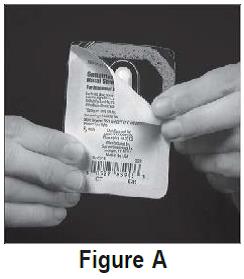
Step 1. Remove the Sumatriptan Nasal Spray unit from the plastic pack (see Figure A).
Do not remove the unit until you are ready to use. The unit contains only 1 spray. Do not test before use.
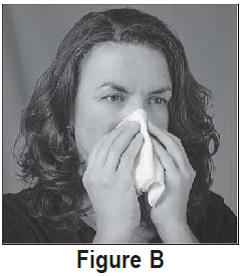
Step 2. While sitting down, gently blow your nose to clear your nasal passages (see Figure B).

Step 3. Keeping your head in an upright position, gently close 1 nostril with your index finger and breathe out gently through your mouth (see Figure C).
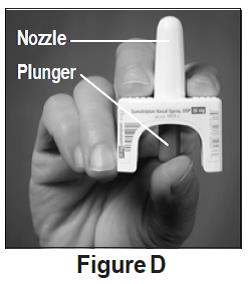
Step 4. With your other hand, hold the container with your thumb supporting the container at the bottom, and your index and middle fingers on either side of the nozzle (see Figure D).
Insert the nozzle into your open nostril about ½ inch.
Do not press the plunger yet.
NOTE: Plunger color may vary.

Step 5. Keep your head upright and close your mouth. While gently taking a breath in through your nose, press the plunger firmly, straight up toward the nozzle, in one rapid motion to release the dose of Sumatriptan Nasal Spray (see Figure E). The plunger may feel stiff and you may hear a click.
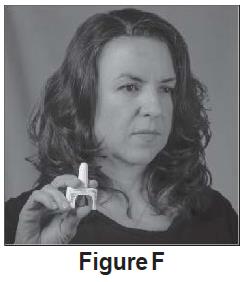
Step 6. Keep your head level and remove the nozzle from your nostril. While holding your head level, gently breathe in through your nose and out through your mouth for 10 to 20 seconds (see Figure F).
Do not breathe in deeply.
This Patient Information and Instructions for Use have been approved by the U.S. Food and Drug Administration.
Manufactured for:
Lannett Company, Inc.
Philadelphia, PA 19136Manufactured by:
Summit Biosciences, Inc.
Lexington, KY 40511509701 Rev. 05/2019
- PRINCIPAL DISPLAY PANEL — 5 mg Front Container Label
- PRINCIPAL DISPLAY PANEL — 5 mg Back Container Label
- PRINCIPAL DISPLAY PANEL — 5 mg Blister Pack
- PRINCIPAL DISPLAY PANEL — 5 mg Carton
- PRINCIPAL DISPLAY PANEL — 20 mg Front Container Label
- PRINCIPAL DISPLAY PANEL — 20 mg Back Container Label
- PRINCIPAL DISPLAY PANEL — 20 mg Blister
- PRINCIPAL DISPLAY PANEL — 20 mg Carton
-
INGREDIENTS AND APPEARANCE
SUMATRIPTAN
sumatriptan sprayProduct Information Product Type HUMAN PRESCRIPTION DRUG Item Code (Source) NDC: 0527-1818 Route of Administration NASAL Active Ingredient/Active Moiety Ingredient Name Basis of Strength Strength SUMATRIPTAN (UNII: 8R78F6L9VO) (SUMATRIPTAN - UNII:8R78F6L9VO) SUMATRIPTAN 5 mg in 0.1 mL Inactive Ingredients Ingredient Name Strength WATER (UNII: 059QF0KO0R) SULFURIC ACID (UNII: O40UQP6WCF) SODIUM HYDROXIDE (UNII: 55X04QC32I) POTASSIUM PHOSPHATE, MONOBASIC (UNII: 4J9FJ0HL51) SODIUM PHOSPHATE, DIBASIC, ANHYDROUS (UNII: 22ADO53M6F) Packaging # Item Code Package Description Marketing Start Date Marketing End Date 1 NDC: 0527-1818-43 6 in 1 CARTON 02/19/2016 1 0.1 mL in 1 BLISTER PACK; Type 0: Not a Combination Product Marketing Information Marketing Category Application Number or Monograph Citation Marketing Start Date Marketing End Date ANDA ANDA204841 02/19/2016 SUMATRIPTAN
sumatriptan sprayProduct Information Product Type HUMAN PRESCRIPTION DRUG Item Code (Source) NDC: 0527-1859 Route of Administration NASAL Active Ingredient/Active Moiety Ingredient Name Basis of Strength Strength SUMATRIPTAN (UNII: 8R78F6L9VO) (SUMATRIPTAN - UNII:8R78F6L9VO) SUMATRIPTAN 20 mg in 0.1 mL Inactive Ingredients Ingredient Name Strength WATER (UNII: 059QF0KO0R) SULFURIC ACID (UNII: O40UQP6WCF) SODIUM HYDROXIDE (UNII: 55X04QC32I) POTASSIUM PHOSPHATE, MONOBASIC (UNII: 4J9FJ0HL51) SODIUM PHOSPHATE, DIBASIC, ANHYDROUS (UNII: 22ADO53M6F) Packaging # Item Code Package Description Marketing Start Date Marketing End Date 1 NDC: 0527-1859-43 6 in 1 CARTON 02/19/2016 1 0.1 mL in 1 BLISTER PACK; Type 0: Not a Combination Product Marketing Information Marketing Category Application Number or Monograph Citation Marketing Start Date Marketing End Date ANDA ANDA204841 02/19/2016 Labeler - Lannett Company, Inc. (002277481) Establishment Name Address ID/FEI Business Operations Lannett Company, Inc. 829757603 ANALYSIS(0527-1818, 0527-1859) Establishment Name Address ID/FEI Business Operations Summit Biosciences, Inc. 832920081 ANALYSIS(0527-1818, 0527-1859) , LABEL(0527-1818, 0527-1859) , MANUFACTURE(0527-1818, 0527-1859) , PACK(0527-1818, 0527-1859)
© 2025 FDA.report
This site is not affiliated with or endorsed by the FDA.
